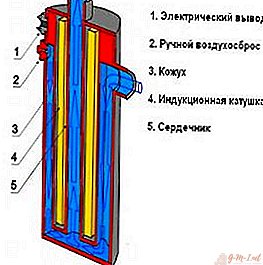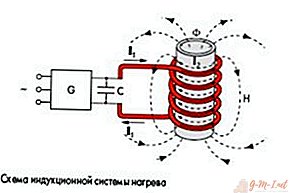 Induction boilers are a fairly new, but quickly gaining popularity heating equipment.They are widely distributed due to the fact that when used, unlike conventional electric boilers withTENami, do not emit any harmful substances for both humans and the environment. Then, how to install an induction boiler for heating a house is very profitable from an economic point of view, and it also helps to heat a room much faster.
Induction boilers are a fairly new, but quickly gaining popularity heating equipment.They are widely distributed due to the fact that when used, unlike conventional electric boilers withTENami, do not emit any harmful substances for both humans and the environment. Then, how to install an induction boiler for heating a house is very profitable from an economic point of view, and it also helps to heat a room much faster.
For greater savings, you can assemble an induction boiler with your own hands. However, it is worth considering that this is not an easy task, and you can’t do without minimal skills. Knowledge will be required both in assembly and installation, and in electronics. In the ideal case, it is necessary to carry out accurate calculations so that a device that fully satisfies your needs and does not fail when you turn it on the first is released.
IMPORTANT. The use of an induction boiler implies a long stay in working condition, therefore it is important that the device is assembled correctly and without neglect. Otherwise, an accident is likely.
Device
 Before proceeding with the procurement of materials, it is necessary to familiarize yourself with the device of the induction boiler in order to understand whether you can assemble such a unit with your own hands. Everyone has their own capabilities, and it is important to approach their assessment wisely.As the name implies, such boilers operate on the basis of the emerging electromagnetic induction, which, in turn, contributes to the formation of eddy currents. It is under their influence that conductive materials are heated. Induction occurs due to alternating current. For its passage, it is necessary to perform a winding in the form of a coil, inside which a heating element is placed (it is used as a second short-circuited winding). In the heater, based on its properties, electromagnetic energy is converted into heat.
Before proceeding with the procurement of materials, it is necessary to familiarize yourself with the device of the induction boiler in order to understand whether you can assemble such a unit with your own hands. Everyone has their own capabilities, and it is important to approach their assessment wisely.As the name implies, such boilers operate on the basis of the emerging electromagnetic induction, which, in turn, contributes to the formation of eddy currents. It is under their influence that conductive materials are heated. Induction occurs due to alternating current. For its passage, it is necessary to perform a winding in the form of a coil, inside which a heating element is placed (it is used as a second short-circuited winding). In the heater, based on its properties, electromagnetic energy is converted into heat.
The simplest induction boiler includes the following elements:
- coil;
- heat exchanger;
- terminal box;
- control cabinet;
- inlet and outlet nozzles.
In industry, an induction boiler is usually represented by a heat exchanger acting as a core, with a winding connected to a high-frequency converter.
Inside the heat exchanger, a coolant is necessarily located, the heating of which occurs under the influence of eddy currents. Connecting the pump allows you to avoid exactly the difference between the temperatures of the inlet and outlet pipes for the coolant - thanks to it, the natural coolant circulates in the boiler.
Almost any liquid can be used as a coolant. Often pour antifreeze and oil, however, in order to save for this purpose, you can use ordinary water. Even without this, it is not necessary to undergo any cleaning, since the system constantly vibrates at high frequencies, and the scum simply does not have the potential for precipitation. The same applies to other impurities.
IMPORTANT. Using an induction boiler without a coolant is impossible and even emergency, since the entire device will be subject to uncontrolled heating, which not all of its elements can survive.
As the outer shell, it is best to give preference to metal, without saving on insulation: both thermal and electrical protective.
There are no restrictions on the shape of the boiler. Compared to electric in induction, there is no need to install a tank, so they differ in their modest size.
Scheme and drawings
Skillful pens have long been fond of assembling induction boilers at home. They went through a lot of variations, many of which, albeit interesting, but do not have the necessary benefits or safety. Nevertheless, successful models quickly gained popularity on the Internet. They are preferred not only by those people who are interested in assembling boilers for the sake of enthusiasm, but also those who need to use the device for its primary purpose - to heat the house. The most popular are the following options:
 Using power from a welding inverter. This is considered a simple option for self-assembly of an induction boiler, however, you will need to pay a lot of attention and strength to a high-frequency converter - it is precisely as it is used that the welding inverter.
Using power from a welding inverter. This is considered a simple option for self-assembly of an induction boiler, however, you will need to pay a lot of attention and strength to a high-frequency converter - it is precisely as it is used that the welding inverter.- Based on induction cooker. This method is advantageous to use if you have an unnecessary induction cooker. Acquiring it for such a purpose is clearly irrational. To do this, it is necessary to disassemble it and get out the copper wire - it will serve as a winding in the induction boiler. The control panel is reconfigurable for the boiler so that it can be used to adjust the power.
IMPORTANT. Plates have power limitations, so it is important to initially perform the calculations so that when you first start everything will not burn out right away.
How to do it yourself
You can assemble a simple induction boiler without using an inverter or stove. They, in fact, only replace some elements.
For everything to work out, you need to strictly adhere to the algorithm of actions:
 Cut stainless wire with a diameter of 7-8 mm into pieces of 5 cm.
Cut stainless wire with a diameter of 7-8 mm into pieces of 5 cm.- Pick up a plastic pipe with a diameter of about 50 mm. It will be required to assemble the case.
- At the bottom of the pipe, install a fine wire mesh of metal.
- Fill the tube with chopped wire (this will act as a metal labyrinth), also cover with a mesh on top. It is important to select materials so that the wire does not crawl through the mesh cells.
- Wind at least a hundred turns of copper wire tightly around the pipe. The winding should be as neat as possible!
- Attach the pipes to the heater, which will subsequently connect it to the heating and plumbing systems of the house.
Important assembly recommendations
When planning an independent assembly of an induction boiler, keep in mind that it will require you to have skills in using a welding machine and a three-phase transformer.
However, the use of self-assembly induction boiler is limited. It is suitable only for installation in closed heating systems with forced air circulation.. The wiring can be performed only with pipes made of plastic or propylene.

The system can be secured by installing a blast valve. It saves the boiler from unnecessary air and normalizes working pressure.
When installing the boiler, care should be taken that it does not come into contact with any surface. A distance of about 30 cm is considered optimal. This will protect you from the spread of consequences in the event of unforeseen situations such as overheating.

 Using power from a welding inverter. This is considered a simple option for self-assembly of an induction boiler, however, you will need to pay a lot of attention and strength to a high-frequency converter - it is precisely as it is used that the welding inverter.
Using power from a welding inverter. This is considered a simple option for self-assembly of an induction boiler, however, you will need to pay a lot of attention and strength to a high-frequency converter - it is precisely as it is used that the welding inverter. Cut stainless wire with a diameter of 7-8 mm into pieces of 5 cm.
Cut stainless wire with a diameter of 7-8 mm into pieces of 5 cm.
Leave Your Comment